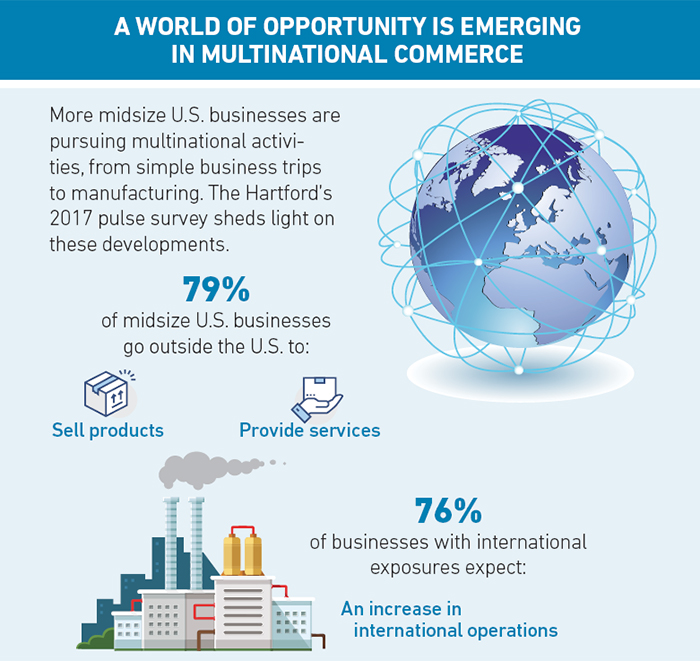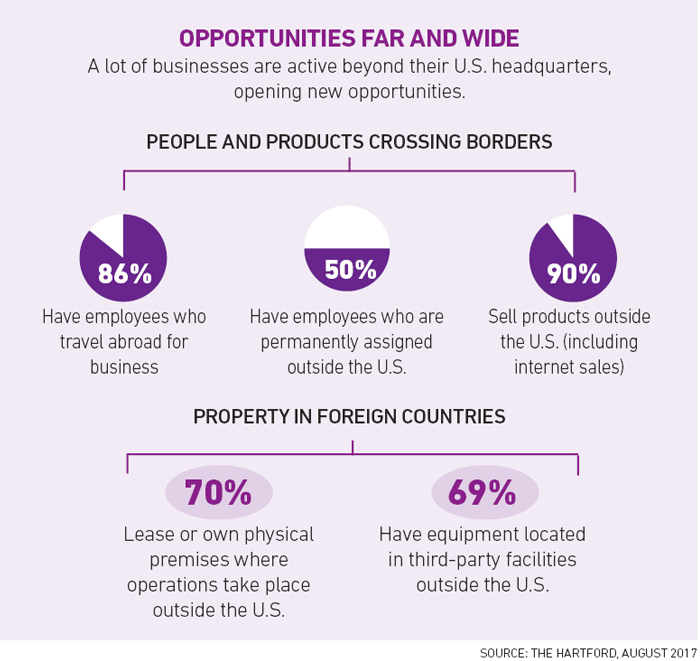Risk Focus: Regulatory
Demand for International Business Insurance Increasing

In this increasingly globalized world, more and more companies are expanding their boundaries, trading across different time zones and borders and moving into new territories.
Many have already built up an extensive network of offices, operations, assets and personnel across the globe.
But they also face a multitude of challenges in establishing and maintaining international trade.
These can include differing business customs and cultures, political and legal environments, tax and insurance regulations, languages, geography and climate, not to mention cyber attacks and terrorism.
“There’s never been a time of greater peril or opportunity,” said Nick Batten, vice president of global services, FM Global. “The pace of regulatory change that we are seeing in the financial markets across the world is faster and more capricious than ever before. Companies need to adapt accordingly to meet those changes.”
And with 94 percent of companies saying they plan to grow their operations outside the U.S. within two years, according to a recent survey by The Hartford, that risk is only going to increase.
There are three main insurance options available for a multinational: local policies, a single global policy or a controlled master program (CMP).
The local policies are issued by a licensed-admitted local broker or carrier to insure against risks in that particular country, whereas a single global policy or master policy is generally issued in the insured’s home country and is intended to cover all of its worldwide risks on a non-admitted basis.
A CMP combines both local policies and the single global policy to provide comprehensive coverage and to ensure there are no gaps.
Which option a company chooses depends on the size of its global footprint, exposure, risk appetite, approach to local retention and deductibles, and level of central decision making.
“Not one size fits all,” said Praveen Sharma, global leader, Marsh’s Insurance Regulatory & Tax Consulting Practice. “It all depends on the particular client, their business model, exposure and risk appetite.”
Key Considerations
Before entering into a global insurance program, Sharma said companies should first work with a knowledgeable broker and insurer to determine their risk, the regulatory and tax requirements in that country and why they need to buy an insurance policy.
Then they need to find a program that provides comprehensive coverage at a reasonable cost and complies with the necessary laws and regulations, he said.
“It is paramount that the insurable risks of the U.S.-based group are insured in an appropriate manner and that the global insurance program responds in the expected manner in the event of a loss suffered by the U.S.-based insured group,” said Sharma. “The insurance program therefore must be structured in a manner that is ‘fit for purpose’ and meets the insurance needs and expectations of the multinational group and is as compliant as possible from both a regulatory and a tax perspective.”
Another key consideration is the growth of third party risks within the supply chain, said Kathrin Howard, practice leader, Allianz Multinational, USA.
“Companies need to understand all the components of their supply chain and find a program that can help them to mitigate that risk,” she said. “It’s also important to have a back-up plan should the worst happen.”
Central to developing a successful program is also being consistent and ensuring retentions and terms and conditions are similar across all borders, said Lou Capparelli, executive vice president at Chubb’s Global Casualty Business in the North America Major Accounts Division.
“Those U.S.-based multinational companies that are successful in addressing these challenges typically have programs in place that provide uniformity in the limits and types of coverage they purchase to address worldwide exposures,” he said.
“For example, a deductible recovery program structure can help simplify the process and position companies to better retain desired portions of risk globally, while ensuring they are compliant with local regulations and tax requirements.”
Local vs. Global Policy
Some countries may require local operations to be covered by a local policy issued by a licensed local carrier, certain terms and conditions may only be available in the local marketplace, or the local subsidiary may also be required to calculate and settle local premium taxes itself.
The main advantage of buying local policies is that they meet local industry practices and regulatory requirements, provide access to local reinsurance pools as well as fulfilling local contractual obligations, and enable local claim servicing and payment of claims, premiums and premium taxes.
“Certainly in the past a more centralized approach would have made sense, but now, given the current wave of nationalism and the development of local markets, a more local or regional approach may be more appropriate,” said Aon’s Global Client Network U.S. leader Kathleen Lynch.
“Also, there are certain countries and local markets that require local insurance, so those nuances have to be factored in with developing a program.”
With a single global policy, the company can assess its risks and insurance needs centrally and provide consistent terms and conditions, limits and umbrella attachment points for its worldwide operations, particularly for cyber and environmental.
However, AIG Multinational’s president Carol Barton warned against choosing a global policy at the expense of local policies.
“Clients should be well-versed on the potential limitations they may encounter should they choose to forgo local policies,” she said. “In particular, multinationals should be aware of the potential pitfalls a lack of local coverage could create in the areas of compliance, claims, income tax, proof of insurance and coverage.”
With a CMP, however, you get the best of both worlds, with the global policy providing difference in conditions or difference in limits to bridge any gaps in the local policies, particularly in property, international casualty and D&O.
It also provides coverage if a claim is either not covered under a local policy or the local policy limit is exhausted, and covers risks in countries where there are no local policies.
“That’s the way a large percentage of multinationals are operating now under a CMP,” said Claude Gallelo, managing director and leader, Willis Towers Watson’s Global Network Practice. “It gives them the advantage of having a local policy as well as that added element of protection by being better able to control their overseas operations with a master program.”
Tim Bunt, chief risk officer, CBRE, a commercial real estate firm present in 120 countries, said his company uses all three approaches.
“In some cases we use a global policy, in some it’s a CMP and in others we’ll have local policies in those countries,” he said. “The approach you choose depends on what you are trying to achieve as a company with your overseas operations.”
Risk Transfer and Mitigation
One way to further mitigate or transfer risk is to insert a financial interest clause, said Joanna Roberto, a partner at Goldberg Segalla’s New York office.
This allows the parent to shift certain risks to or away from its subsidiaries by only covering its own financial interest in that particular subsidiary, she said.
“A financial interest clause is an interesting concept because it completely avoids the risk of losses that are suffered by a subsidiary by expressly not insuring them under the master policy,” she said.
“Indeed, there are other variations of the clause which require evaluating the parent company’s ownership interest against the loss sustained by the subsidiary.”
Another loss prevention technique, said Smita Bhugava, senior vice president, Clements Worldwide, is to have an action plan to deal with any potential events, to reinforce best practices and to share knowledge with peers and experts in that country.
“The world and the exposures we face are becoming more complex and varied,” she said. “So you need to have a well-thought-out strategy that will address all of these issues and ensure that you don’t have any nasty surprises.” &












